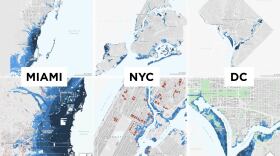-
WMFE examines the devastation Hurricanes Ian and Nicole brought on Central Florida, and how some areas rebuild in an area that's known to flood as storms become more intense due to a changing climate.
-
The impacts of Hurricanes Ian and Nicole were especially devastating on the inland communities of Central Florida.
-
The main objectives of the plan are 11 goals that include everything from strengthening local infrastructure to increasing sustainability.
-
Southwest Florida has already answered the immediate question after Hurricane Ian slammed into the coast, killing dozens of people and destroying thousands of homes with record-high storm surge: Will we rebuild?
-
As federal agencies and local governments reassess flood zones and incorporate new technology, data on sea-level rise and the fact that the concrete jungle doesn’t absorb as much water as the natural environment, they’ve concluded that vast swaths of South Florida — particularly inland areas — are vulnerable to crippling storm surge and flooding from rain.
-
If passed, Floridians who prepare for flooding, rising sea levels, and natural disasters by elevating their homes can do so without their property taxes increasing.
-
It’s a question that follows any natural disaster, especially monster hurricanes like Ian: Was this caused by climate change?
-
Hurricane Ian came ashore with devastating near-Category 5 winds that peeled the roofs off homes and uprooted trees.
-
Rising seas will shift tidal boundaries, leading to the loss of taxable properties, according to a new study. This is expected to impact the tax base of hundreds of U.S. coastal counties, with Florida being the state most affected.
-
NOAA projects that the high tide flood frequency between May 2022 and April 2023 will average 3-7 days, the same as the previous year, but an increase from the 2-6 days expected between 2019 and 2020.
-
Harris says the U.S. government is partnering with groups in Miami-Dade on $50 million to protect low-lying neighborhoods from flooding caused by sea rise and hurricane storm surges.
-
National Hurricane Center data for Miami, Washington, D.C., and New York City show development happening in at-risk areas, even as climate change brings more frequent and intense storms.
Play Live Radio
Next Up:
0:00
0:00
Available On Air Stations












